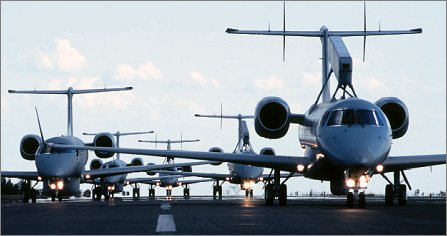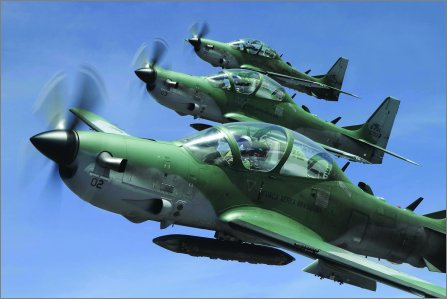On the eve of South America’s FIDAE show, Embraer sees strong demand for special-mission ERJ-145s, but is keeping an eye on the market for a larger aircraft
Embraer is studying special-mission versions of its E-170/190 large regional-jet family, but expects derivatives of the 50-seat ERJ-145 to dominate its military sales despite losing a key US contract.
|
| Brazil's Amazon surveillance requiremnt gave Embraer its start in special mission ERJ-165s |
Airborne early warning and control (AEW&C) and maritime patrol aircraft (MPA) derivatives of the ERJ-145 are being offered in contests in South-East Asia and the Middle East. And with the FIDAE 2006 show to be held in Santiago, Chile from 27 March to 2 April, South American interest in special-mission aircraft is growing.
As a subcontractor to Lockheed Martin on the Aerial Common Sensor (ACS) programme, Embraer proposed the E-190 after the mission system outgrew the original ERJ-145, but the US Army elected to cancel the $879 million development contract (Flight International, 17-23 January).
Embraer has not given up on the US military market – or a larger special-mission platform. The manufacturer is monitoring US Department of Defense efforts to evolve the ACS requirement into a tri-service multi-intelligence platform while it continues to study special-mission applications of the E-170/190 family.
“There are certain MPA and AEW requirements around the world for which the 190 is an alternative, but we have not launched anything yet,” says Anastacio Katsanos, Embraer vice-president, product strategies, military market. “It’s a different class of aircraft. The requirements are fewer than for 145-size aircraft, and the investment required much higher, but there are several competitive requirements for an aircraft in that class.”
Compared with the highly common ERJ-145 family, the four-model E-170/190 series potentially offers different wing, engine and fuselage combinations that give greater freedom to adapt the platform to the payload, Katsanos says, ranging from the smaller E-170 to the larger E-195. “For ACS we went to the 190 for more future growth,” he says. “But a number of 145 applications could migrate to the 170 and benefit from more endurance, consoles and communications, with the option to go to the 190 for more sensors and operators.”
The E-170/190’s fly-by-wire digital flight-control system would also give Embraer greater freedom in coming up with technical solutions to centre-of-gravity and aerodynamic issues associated with locating internal systems and mounting external antennas, Katsanos says. But a larger special-mission platform lies in the future. For now, the priority is on finding new applications for the ERJ-145 airframe.
Embraer broke into the special-mission market through Brazil’s SIVAM Amazon surveillance programme, as prime contractor for the airborne segment comprising the EMB-145SA AEW&C, EMB-145RS airborne ground surveillance (AGS) and EMB-314 Super Tucano light attack aircraft. Developments of these aircraft now form the basis of Embraer’s military business.
The SIVAM programme to combat illegal activity in the Amazon provided Embraer with its first experience of integrating special mission systems on to the ERJ-145, installing the Ericsson Erieye phased-array radar to produce the AEW&C and working with SIVAM prime contractor Raytheon to develop the AGS variant.
Embraer subsequently delivered an AEW&C version to Mexico, for counter-drug operations, and the aircraft is entering service with Greece. “In the case of Greece, non-NATO access restrictions on the datalink required Thales and Ericsson to do the integration,” says Katsanos. Raytheon, meanwhile, sold its Integrated Systems unit to L-3 Communications, which became Embraer’s partner on the AGS variant.
Comparing the EMB-145RS to the UK’s Raytheon-developed, Bombardier Global Express-based Airborne Stand-Off Radar (ASTOR) platform, Katsanos says the aircraft is a “mini-ASTOR, but multi-mission”, combining synthetic-aperture radar (SAR), communications intelligence (COMINT), electronic intelligence (ELINT), multi-spectral and electro-optical (EO) sensors.
|
| Super Tucano is beginning to win export orders |
“The RS is more important strategically than the AEW in the Amazon,” Katsanos says, because most of the illegal activity is on the ground. “We have not exported the aircraft so far, but we have had a number of enquiries,” he says. “The requirements are less than for AEW in quantities, but the modifications are more expensive.”
The RS formed the basis of the EMB-145MP maritime-patrol aircraft supplied to Mexico for counter-drug operations. “In addition to the AEW, Mexico needed a version to monitor Pacific and Caribbean waters as well as littoral areas to look for fast boats,” he says. “We took the RS and made it into an unarmed MPA.”
Embraer is addressing maritime strike and anti-submarine missions by evolving the Mexican configuration, adding acoustic sensors and weapon hardpoints. Missions beyond AEW&C and MPA could include target towing and aerial photography. There are also three potential customers for a signals-intelligence version, Katsanos says.
But the US Army-led ACS programme was Embraer’s biggest prize and most challenging task. “AEW and MPA together were similar to ACS,” says Katsanos, as the mission system included SAR, EO, COMINT, ELINT, SIGINT sensors, satellite communications and on-board operators. Lockheed’s selection of a 50-seat regional jet as the platform was controversial, but both companies are adamant that, at the time of contract award in August 2004, the ERJ-145 met the requirements. “ACS was within the margin of the design,” says Katsanos.
Army acquisition executive Claude Bolton told Congress late last year that Lockheed’s proposal “projected a weight nearly 3,500lb [1,600kg] below the threshold limit”. Even after factoring in risk, “neither the government team nor the contractor anticipated the nearly 6,400lb weight growth that was ultimately realised as the design progressed”, he said.
The US Army has blamed the problem on inadequate models for predicting mission system weight. But Embraer’s position as a non-US supplier was a complication. “As the requirements became clearer, we did not have access to certain information,” Katsanos says. “We had a rough idea of the mission package, but our level of involvement did not go so deep into the integration. We began to see a concern, but could not contribute to identifying the problems sooner.” The move to the larger E-190 came too late to save the contract.
Despite the setback, Embraer is confident of the ERJ-145’s special-mission potential. Even with exports of the Super Tucano, and upgrades of the Northrop F-5 and Aermacchi/Alenia/Embraer AMX for Brazil, the intelligence, surveillance and reconnaissance market is expected to remain the company’s biggest source of military revenues.
GRAHAM WARWICK / WASHINGTON DC
Source: Flight International


















